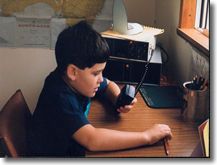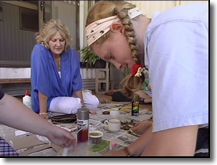School of the Air - Australian Children

Many children in Australia live in remote areas which we call "The Bush" many of these children have been schooled by a combination of home schooling from parents and via the School of the Air a uniquely Australian way of getting an education by using an HF radio receiver to communicate with the school teacher and your class mates.
School of the Air
Australians are great inventors because this vast arid continent constantly challenges us to be innovative: Necessity is the mother of invention. So how do children living in remote areas get an education? Our solution is the ‘School of the Air”
This is a story about a day in the life of an 8-year-old child living in Australia on a Cattle Farm 300 kilometres from the nearest school. He leads an active life learning hands on skills from interaction with his family and station workers. His is enrolled in the ‘School of The Air’.

The School of the Air is a unique Australian Correspondence school using a combination of traditional correspondence teaching methods complimented by cutting edge technology.
Jack wakes up at dawn to feed the chickens and let them out of their coop. He then finds his Dad and helps with the other morning chores. Then it is back to the house at 7 am for some breakfast. 8 am is his scheduled class with his teacher. He leaves the kitchen and goes to the study room. He sits in front of the computer and waits for his classmates and teacher to come online. The microphone is in position so the small group will hear his contributions to the lesson. This system is called Interactive Distant Learning (IDL) He has seven half hour lessons using IDL with the School of the Air each week.
On Monday mornings everyone in his School of the Air participates in an assembly using the HF (high frequency) radio. The school supplies the Radio Transceiver for each family. The Australian Government funds the education of all students enrolled in School of the Air, which costs about double the cost of standard education.

Today’s lesson is about using Fractions in Maths. Instead of a blackboard, the teacher uses an electronic whiteboard to demonstrate the use of fractions. A simple presentation introduces a few new ideas. The main lesson points and exercises are prepared in a word document which has been shared for all the students to access instantly on the website. The teacher asks the students questions and all can hear their responses. There is a quick quiz on the website for the students to complete at the end of the lesson. This gives the teacher instant feedback on the students’ current understanding of fractions. The next lesson will be adjusted accordingly. The teacher signs off for the day leaving the students with direction on how to find an online lesson package on Fractions. These E-learning packages have been specifically written to match with Jack’s Mathematics Curriculum.
After the lesson Jack has quiet time to work alone on his projects. Some times a tutor will come to help him through certain subjects. His sister did the same lessons 3 years ago so he can ask for her ideas and direction. His mum helps him too, making sure he studies at least 5 hours a day. He has writing books, pens and traditional learning materials organised in his desk. Each term he receives a learning package in the post with audio and videocassette tapes, library books and computer software. Once a year all of his friends go to a classroom in the town for one week. Jack’s favourite day was when they played football on Friday. During the week he got to know his teacher who he can phone on the free call 1800 number. They usually practice reading together. Jack is looking forward to camp again next year. He will spend time with his fellow students and teachers face to face. They are going on camp with the ‘townies’ who attend the school in town. One of the townies is in Jack’s study group. She is sick and can’t go to a standard school so she joined the School of the Air.
Another highlight of the year is the mini-school. This year it is going to be at Tim’s house. Last year Jack’s family hosted the event. Libby Standley, a guest teacher specialising in Writing and Drawing for Children’s Literature, came to visit for three days and all the local (relatively speaking) kids came to stay. They didn’t fit in the lounge room so they cleared out the Shearing Shed and had the workshops there. Jack drew some amazing pictures that are on display in the Tourist Centre. This year an African Dancer, Sheelagh Langerburg, is coming to stay for three days. Cool! Everyone is really excited.
For now Jack is free to go back outside. His new horse is waiting for him, there are cows to muster with his Dad and that Maths eLearning unit can wait until the afternoon study period.
Jack’s Dad completed his schooling though the School of the Air in 1975. They didn’t have the Internet back then but things weren’t so different. Jack’s dad sat down in front of his radio each morning for a ten-minute session with his teacher. She would give him a list of work and assignments to work on that day. They didn’t have camps, mini-schools and classroom time like Jack does now. Nevertheless, he finished his schooling and stayed on the land like his father before him and as Jack plans to do. Jack’s son will likely be a student of the School of the Air. The technology that will be available to him is beyond our imagination.
The modern day School of the Air has evolved over the decades to incorporate new technologies and adapt to the changes in curriculum. One of our great Aussie ideas was the invention of the pedal powered radio by Alfred Traeger in 1929. This radio network was a corner stone of providing health and medical treatment to remote families. The founders of the Royal Flying Doctor Service extended these services to include education for remote families. They set up the first Australian School of the Air in the 1950’s. The radio network was a very effective way to provide interactive lessons for small groups of children.
We no longer rely on pedal powered radios to communicate, however we continue to lead the way in developing communication technology to meet our unique Australian needs. The Australian government has recognised the need to invest in communications infrastructure. Since 2003 over 30,000 school students have entered a new era in online education. Residents of the Northern Territory and parts of NSW have access to real-time streaming video, high-resolution graphics, full duplex audio, two-way data interaction and application sharing capabilities. This is possible due to the use of two-way and one-way satellite technologies to deliver broadband Internet provider services. A main satellite in Sydney is linked to teaching studios in Darwin, Alice Springs, Port Macquarie, Dubbo, and Broken Hill. For the Alice Springs School of the Air, which has 120 students distributed through an area over a million square kilometres, this technology is far superior to relying on the postman to deliver schooling materials and return assignments.
UPDATE: We've researched and compiled info on the best bank accounts for kids in Australia too which you might find interesting.
